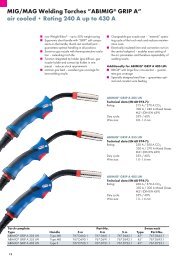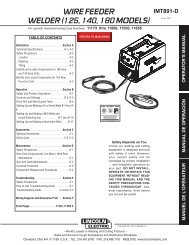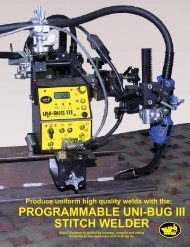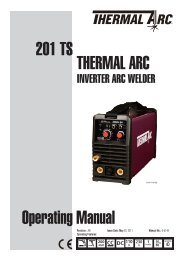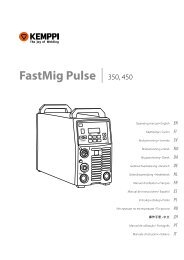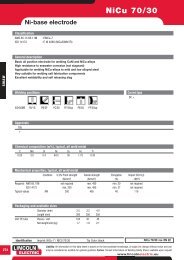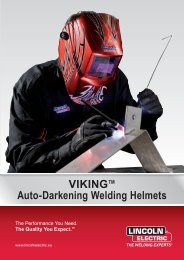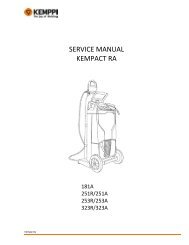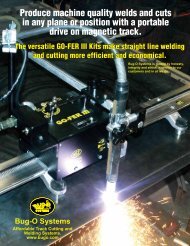mig welding - Rapid Welding and Industrial Supplies Ltd
mig welding - Rapid Welding and Industrial Supplies Ltd
mig welding - Rapid Welding and Industrial Supplies Ltd
Create successful ePaper yourself
Turn your PDF publications into a flip-book with our unique Google optimized e-Paper software.
TIPSAdditional Metal Surcharge(s) May ApplyAluminium Soldering <strong>and</strong> BrazingSoldering – SIF 555 Aluminium SolderHistorically, engineers have considered that <strong>welding</strong> aluminium presents a range of problems, due to its surfaceoxide <strong>and</strong> that it does not change colour when heated. With the advent of MIG <strong>and</strong> TIG <strong>welding</strong>, it is nowregularly welded with great success. Certain alloys can be gas welded or brazed, but the removal of flux residueis most important, as its corrosive action will continue after the joint has been completed.There is another ‘low temperature’ process, which is called soldering, although the workpiece is melted. Theparts to be joined are heated (even by a small propane burner) <strong>and</strong> the rod rubbed on the work surface. At thecorrect temperature (370ºC), the rod is seen to melt <strong>and</strong> creates an exothermic reaction generating sufficientheat to locally melt the aluminium. An advantage of this process is that flux is NOT required. We refer to thematerial as SIF 555 Aluminium Solder. The product gives high strength deposits that do not have the problem ofgalvanic corrosion between base metal <strong>and</strong> solder. The low working temperature keeps distortion <strong>and</strong>discoloration of the work to a minimum.This process is commonly used by manufacturers of aluminium windows <strong>and</strong> doors. It is ideal for repairing <strong>and</strong>sealing defects in aluminium boats, gutters, engine parts, castings <strong>and</strong> sheets, being especially recommendedfor applications where flux residue removal is a problem.The correct procedure is as follows; cracks <strong>and</strong> joints should be bevelled to a 60º to 90º Vee. Remove all dirt,grease <strong>and</strong> foreign material from the surface to be bonded. For a higher strength bond, roughen the surfacebefore applying the alloy. Using a carburizing flame, heat the part broadly. As the temperature approaches370ºC, rub the rod on the surface to be soldered. Continue heating base metal until enough heat is present tocause the rod to melt off when it is rubbed on the joint. Do not overheat, but be sure the entire joint surface istinned before adding additional alloy to make a build-up. Tinning action may be improved by using a clean,stainless steel wire brush to brush through the molten metal to the base metal surface. Allow part to cool slowly.Brazing – Sifalumin No16 & Aluminium FluxTraditionally Sifbronze referred to the technique as "Process 36", but recently Sifalumin No 36 <strong>and</strong> AluminiumNo 36 flux have been replaced by Sifalumin No 16 which melts approx. 80ºC lower than pure aluminium <strong>and</strong>Aluminium Flux.The process is applicable to pure aluminium <strong>and</strong> alloys with up to 2% magnesium. Other alloys will provedifficult, especially if containing high % of silicon. The joint design should be lap type with a good mechanical fit.Parts must be thoroughly cleaned <strong>and</strong> if magnesium bearing wire brushing is essential. The brazing operationshould be carried out as soon as possible after cleaning .The SIF Aluminium flux is used as a temperature indicator <strong>and</strong> can be applied via the rod or applied direct to theworkpiece as a paste, made by mixing the flux with water. The whole workpiece should be pre-heated with theblowpipe moving backwards <strong>and</strong> forwards along the joint line. As the flux melts, the rod is applied to flow freelyalong <strong>and</strong> through the joint. It is important to avoid overheating which can destroy the properties of Sifalumin No16.Aluminium flux is highly corrosive <strong>and</strong> the residue must be removed within 30 minutes of the brazing operation.Where joints are accessible, wire brush with very hot water or even a steam jet, alternatively treatment with 5%nitric acid solution may be required.www.<strong>Rapid</strong><strong>Welding</strong>.com127Order Before 4pm For NextDay Delivery (Mon-Fri)



